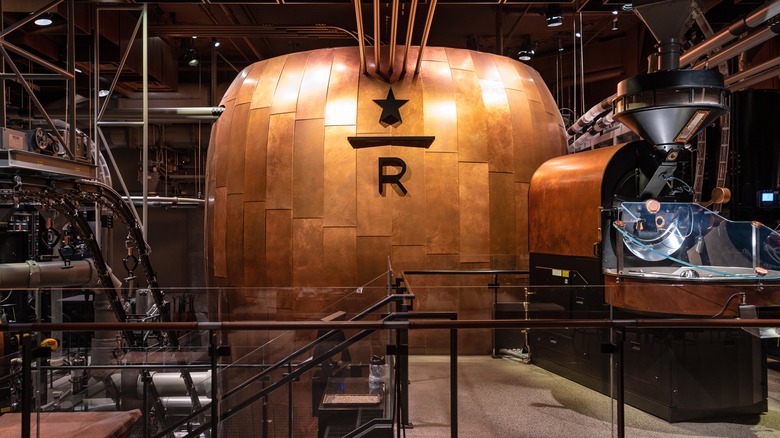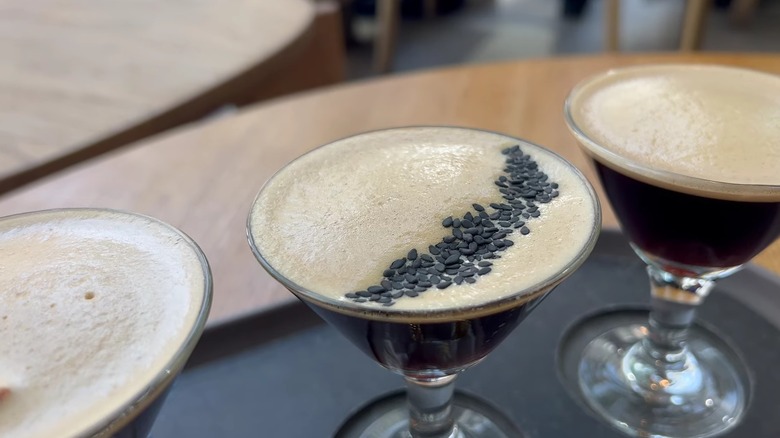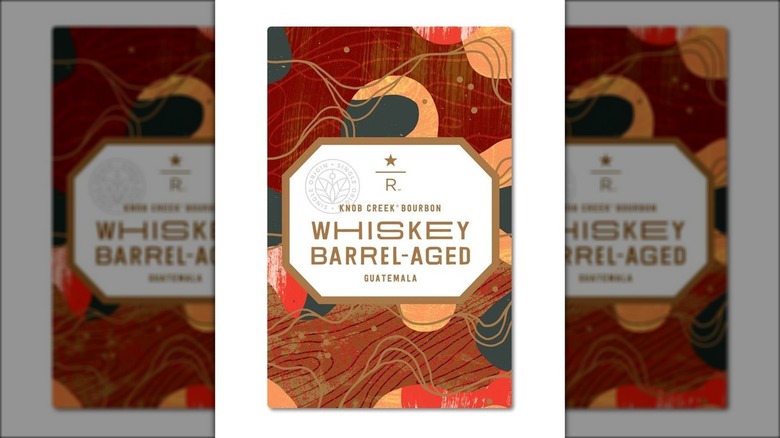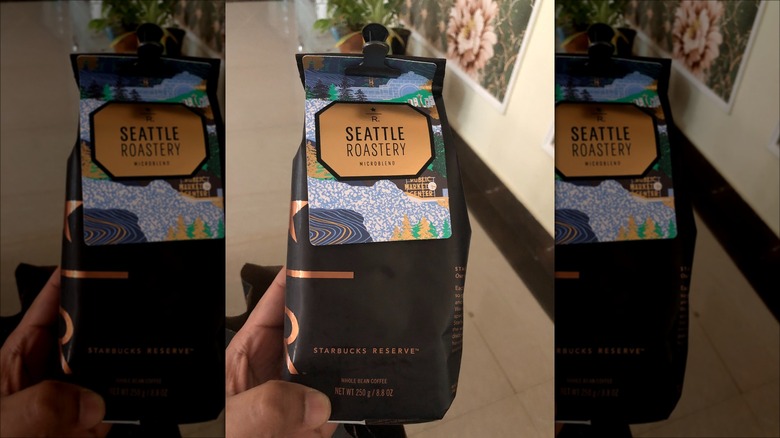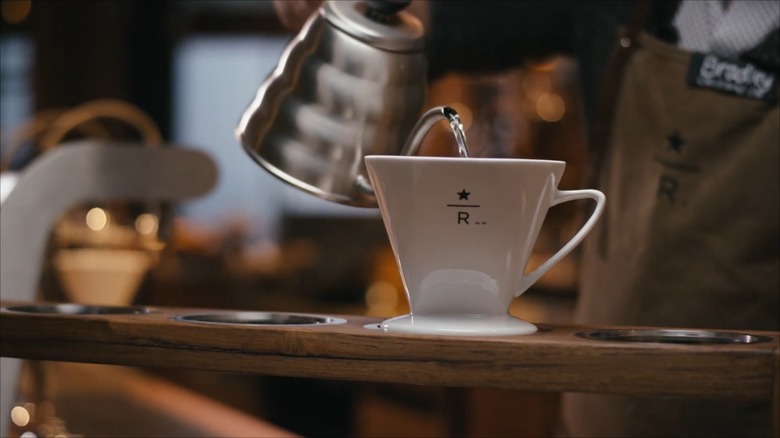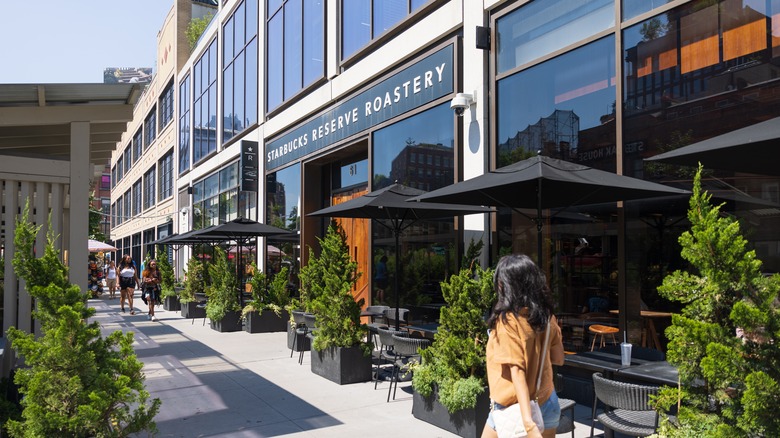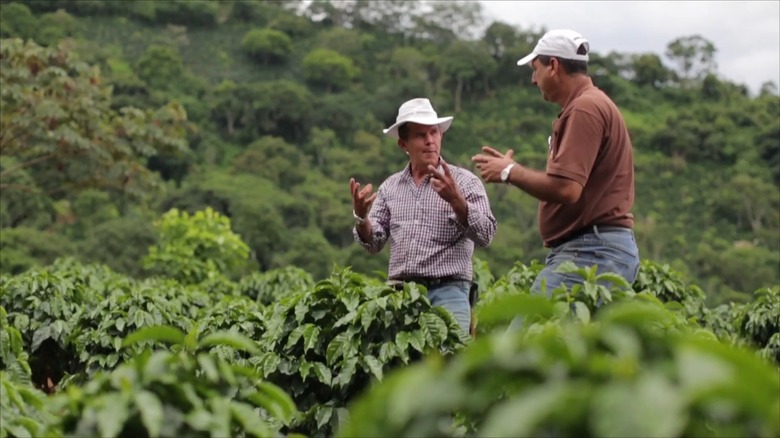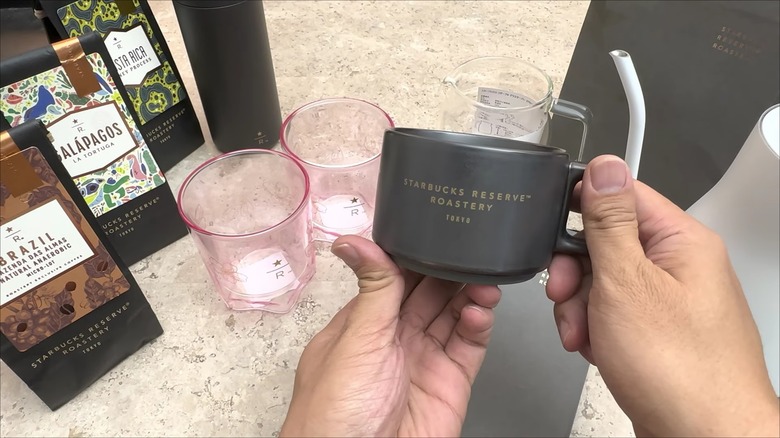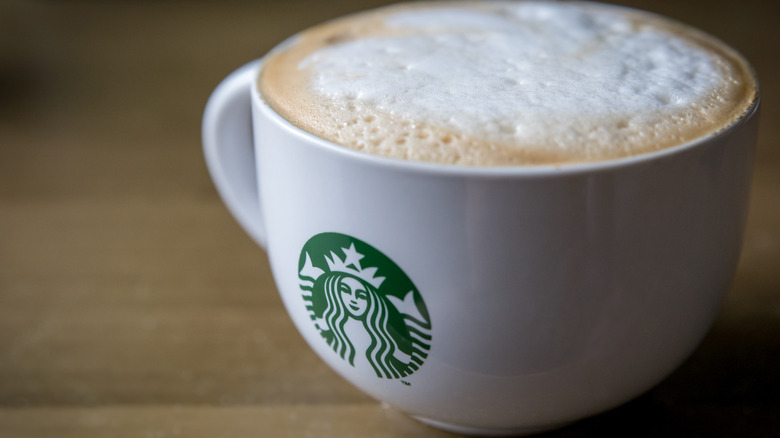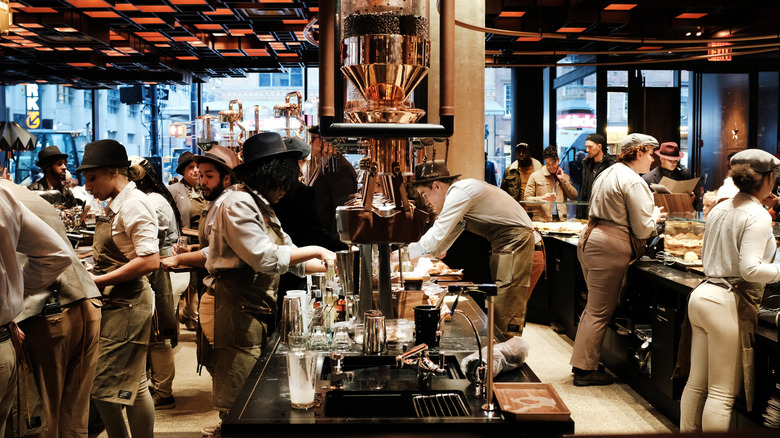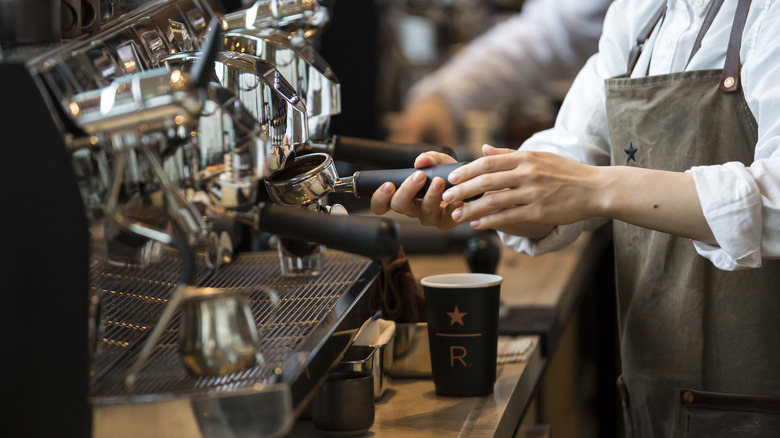What's The Difference Between Starbucks And Starbucks Reserve?
With over 38,000 stores globally, Starbucks is one of the most recognizable food and drink brands in the world. While the company is known for its ability to churn out a cup of coffee, along with various other products, in a quick and consistent manner, it is not often associated with specialty coffee. Starbucks set out to change this in 2004 when it launched a series of single-origin coffees — which often taste stronger than blends — under the name of Black Apron Exclusives. In 2010, this project morphed into Starbucks Reserve, a premium brand that offers high-end coffee products and related experiences at a handful of specially designed roasteries and stores.
Given that both Starbucks and Starbucks Reserve are owned and operated by the same company, customers are often shocked by how much the products and experiences provided by the two brands differ. In this article, we highlight exactly how and why they're so different, providing you with all the information you need to decide whether it's worth sticking with your plain old Starbucks or if it's better to invest your time and money into experiencing something a little more special.
Starbucks Reserve locations sell exclusive food and drinks
Starbucks is not what you'd describe as a high-end chain, and its menu reflects this; food doesn't get much more adventurous than a ham and Swiss cheese baguette, and coffees, while consistent, are not made with the care and exactitude present in specialty coffee shops. This stands in direct contrast to the offerings sold in Starbucks Reserve locations. In these stores, customers can choose from a huge range of exclusive food and drinks, including the Whiskey Barrel-Aged Malt — a milkshake made with cold brew coffee that's been aged in whiskey barrels, together with vanilla gelato and chocolate and orange bitters. The stores also serve a range of exclusive coffee creations such as the Toffeenut Bianco Latte.
In terms of food, Starbucks Reserve blows regular Starbucks offerings out of the water thanks to dishes like Avocado Toast with Pancetta and Egg, Chocolate Ganache Brownies, and Porchetta and Egg on Ciabatta. These refined dishes are unlike any regular Starbucks products. If that wasn't enough, Starbucks Reserve stores even sell a selection of pizza.
Unlike regular Starbucks stores, Starbucks Reserve locations also serve an array of alcohol including beer, wine, and cocktails. Of these, signature cocktails like the Roastery Old Fashioned are the most impressive. This cocktail is made from a blend of Starbucks Reserve cold brew, Iwai Whisky, Amaro Del Capo, maple syrup, balsamic vinegar, and orange. Other drinks like espresso martini flights are also sold in spectacular Starbucks Reserve locations.
Rare coffee products are sold under the Starbucks Reserve brand
While many people opt to experience Starbucks Reserve coffee in-store, others prefer to enjoy their coffee at home. For these connoisseurs, Starbucks Reserve produces and sells a range of excellent, limited-edition coffees. Perhaps the best example of Starbucks Reserve's infatuation with producing great coffee comes via its roastery-inspired microblends. Six different coffees were made in homage to Starbucks Reserve's six roasteries in Milan, New York City, Seattle, Shanghai, Tokyo, and Chicago, which also happens to be the world's largest Starbucks.
Leslie Wolford, one of Starbucks' senior coffee quality development specialists, and several other experts experimented with coffee from 16 different origins to create these unique blends, tweaking them after receiving feedback from each roastery's staff. In an interview with Starbucks, Wolford said, "By co-creating these blends with our Roastery partners who roast, craft, and brew Starbucks Reserve coffee for our customers around the world, we are showcasing their love of coffee craft and translating it into something we all can be proud of."
Starbucks Reserve is also known to collaborate with other premium brands to produce some exciting, innovative coffees. One such example is Starbucks Reserve Knob Creek Bourbon Whiskey Barrel-Aged Guatemala. By aging exceptional coffee beans in Knob Creek's Kentucky Straight Bourbon Whiskey barrels, Starbucks Reserve created a coffee that boasts a huge amount of flavor.
Starbucks Reserve coffee products come with unique cards
If you buy Starbucks' regular ground coffee or coffee beans you will likely remain unimpressed with the packaging. While the bags these products come in are usually decorated, there's little that makes them stand out from coffees sold by competing brands. The opposite is true of coffee sold under the Starbucks Reserve brand, thanks to the unique cards that accompany each packet.
In an interview with Starbucks Reserve, creative design manager Derek Shimizu said, "We were inspired in part by the labels on high-end wine bottles [...] We ran with that idea for our coffee cards, but wanted to take it to the next level. Every single card is custom designed for each coffee, down to the hand-drawn typefaces." Each of these cards is designed to represent what makes that particular coffee special, celebrating distinct features of the landscape where it was grown and the characteristics that are present in the final cup.
Aside from making the products distinct, these cards are also designed to be collector's items. Over 180 cards have now been created by some 50 artists, meaning there is plenty of scope for those passionate about the cards to build their collection. It's these small, luxurious details that really differentiate Starbucks Reserve products.
Starbucks Reserve locations offer many bookable experiences
Most customers' trips to Starbucks are short, fast affairs. They order their drink, pick it up, and then leave. However, Starbucks Reserve locations encourage customers to spend prolonged periods of time in the store and learn about the coffee via a range of bookable experiences.
The majority of these experiences place coffee front and center. For example, Coffee Lab: A Journey of the Senses sees baristas educating customers on how to identify the myriad flavors and aromas present in two different single-origin coffees. These tastings offer customers a great opportunity to learn more about coffee. As one happy customer highlighted on TripAdvisor, "Once we found a seat at the Experience Bar our Barista, Lincoln gave us incredible service never making us feel rushed or dumb for asking different questions about what we were tasting."
Other experiences lean into the unique nature of Starbucks Reserve locations with private tours being offered of the iconic buildings, including Starbucks Reserve's Chicago roastery. Other experiences utilize the expertise of bartenders; Art of the Espresso Martini gives customers the opportunity to learn how to make an espresso martini, a classic cocktail, under the guidance of Starbucks Reserve's master mixologists.
Regular Starbucks locations are much more common
According to Starbucks itself, the company boasts some 32,000 stores in 80 countries. This means that, whether you are in New York or Berlin, Hong Kong or Mexico City, you're never far away from a regular Starbucks store. The same cannot be said for Starbucks Reserve locations which are far less common.
There are two types of Starbucks Reserve locations: Starbucks Reserve roasteries and Starbucks Reserve stores. At the time of writing, there are only six Starbucks Reserve roasteries in the world; one a piece in Seattle, Chicago, New York, Tokyo, Shanghai, and Milan. These multi-story destinations are the pinnacle of the Starbucks Reserve brand, offering a variety of experiences in suave, well-designed settings. In comparison, Starbucks Reserve stores are much more contained affairs that offer food from Princi bakery and Starbucks Reserve coffee. Despite then Starbucks CEO Howard Schultz announcing plans in 2016 to open 1,000 Starbucks Reserve stores, only three are currently open in the United States: the Empire State Building store, the Greenwich Lane store, and the Sodo store.
In conjunction with these two location types is the Reserve Bar, a Starbucks that sells Reserve brand products as well as regular Starbucks products. These locations are more common with an estimated 20 dotted around the U.S. and many others abroad. Even including the Reserve Bars, the total number of Starbucks Reserve locations is well below 1,000 making them much scarcer than regular Starbucks locations.
The Starbucks Reserve coffee beans are meticulously sourced
As a company, Starbucks buys three percent of the world's coffee every year. This coffee is sourced from growers and suppliers around the world, and the company follows its own Coffee and Farmer Equity Practices to ensure that beans are sourced in a fair and transparent manner. While taking such an approach is admirable, the company works on a scale that makes it difficult to ensure these practices are always upheld, as evidenced by recent lawsuits that allege the company has sourced coffee from farms riddled with human rights abuse.
The coffee beans used for Starbucks Reserve products are even more meticulously sourced with Ann Traumann, Starbucks Reserve's specialty coffee trader, traveling the world to experience the coffees at their source. Speaking to Starbucks Reserve, Traumann said, "I am always travelling to origin. I want to have a hands-on understanding of supply chains, see and work directly with farmers on the ground. To show them I am fully engaged and to build trust with them."
During these visits, and in subsequent tasting and experimentation sessions, Traumann and her colleagues evaluate three aspects of the coffee: Its quality, its ability to tell a story, and whether it can be ethically sourced. By examining all these in minute detail, Traumann finds fantastic suppliers such as Rwanda's all-female Hingakawa, ensuring that Starbucks Reserve coffees not only taste great, but that are as ethical and interesting as possible.
Starbucks Reserve locations sell exclusive merchandise
Pumpkin spice isn't the only thing that Starbucks releases seasonally; the company also sells a range of seasonal merchandise in many of its regular stores. These products often include tumblers, cups, and bottles that are designed to celebrate a certain occasion or season. A few basic merchandise products can also be bought online, however this range is very limited.
Each Starbucks Reserve location — whether a roastery or a store — stocks its own unique merchandise that's far superior to what's found in regular stores. High-end coffee brewing equipment, ceramics, and clothes are all available, allowing customers the opportunity to take a little bit of the Starbucks Reserve brand home with them. In an interview with Starbucks Reserve, Jennifer Quotson, a senior member of the Starbucks Creative Studio, said, "It was our goal when we opened the Roastery to do something different. We've embraced that philosophy with an unexpected collection of pieces, selected with the same care as our coffee."
Food and drinks at regular Starbucks is much cheaper
It will come as no surprise that all of the glitz and glamor of Starbucks Reserve does not come cheap. A 12-fluid-ounce latte from the Starbucks Reserve located in the Empire State Building will set customers back $7.50, about two dollars more than the same coffee would cost from a regular New York Starbucks. These discrepancies are also apparent when it comes to ordering food; Starbucks Reserve's Porchetta and Egg on Ciabatta costs $4 more than a similar hot breakfast sandwich sold at other Starbucks locations.
Even the Starbucks Reserve take-home coffee products are expensive with 8.8-ounce packets of whole-bean coffee retailing for almost $20. There are some people who don't think the coffee is worth this price. As one ex-Starbucks employee wrote on Reddit, "You'll find some good ones, but the roasts may still run darker than you'd like. By the cup, costs run similar to a pour over at a boutique coffee shop, so do with that info what you will [...] If you are a regular Starbucks customer, I recommend trying it out as a way to expose yourself to different varietals. Otherwise, probably don't go out of your way to hit Starbucks up for it."
Every Starbucks Reserve store is impressively designed
While the majority of regular Starbucks locations are carbon copies of one another, each Starbucks Reserve location has its own distinct design and style. This is most readily apparent when the six Starbucks Reserve roasteries are compared. Each of these buildings boasts features that celebrate the location in which it sits. For example, the Starbucks Reserve roastery in New York's meatpacking district has a decidedly industrial feel thanks to concrete floors and copper interiors. The characteristics of the building itself were also taken into account when the space was being designed. In an interview with Dezeen, design director Jill Enomoto said, "The really striking quality of the building itself is that it's made up of these beautiful, rigid squares and rectangles, pushed and pulled. We fell in love with the geometry of the building and riffed off that idea."
To aid in the design and development of these unique spaces, Starbucks often works with world-leading architects such as Kengo Kuma. His influence is apparent in the Tokyo Starbucks Reserve roastery. A beautiful, timber-clad building, this roastery has been designed to feature origami-inspired ceilings and spacious balconies.
Staff at Starbucks Reserve are experts in their roles
The vast majority of Starbucks locations are all too happy to hire people who do not have any experience. In fact, many people get their very first barista, front-of-house, or kitchen training at one of Starbucks' many stores. This, however, is not the case at Starbucks Reserve locations which only hire people who are experts in their field.
Having such high employment standards is understandable, given that employees working in these locations are required to master a whole host of skills that regular Starbucks employees are not. For example, a barista working at a Starbucks Reserve location must be able to not only discuss all the different coffees at length, but also use multiple brewing methods, including siphon, pour-over, and stovetop, to make the coffee. The same can be said for the mixologists, front-of-house team, and anyone else who works at Starbucks Reserve stores; customers expect more from these locations and it's down to these skilled employees to provide that high-end, luxurious experience.
